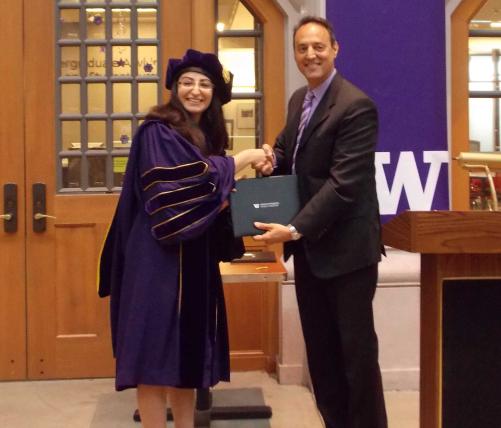By Susie Sargsyan
I loved puzzles and math problems since I was a kid, and that love continued to grow. Even though my parents were against it, I decided to choose math as my career path and got accepted into the department of Mathematics at Yerevan State University. Since Armenia still carried remnants of Soviet methodology, we concentrated on the theory and not applications. After I graduated with Bachelor’s and Master’s degrees, I decided to continue my studies abroad to learn more about the applications of math. I chose to accept an offer from the department of Applied Mathematics at University of Washington as a Master’s student.
In the beginning of my studies, I got lost in the variety of topics I could learn. I chose to start with classes that were close to my background, since it was hard enough to change countries. After the first quarter, I had a chance to apply to continue as a Ph.D. student. Since I only took a couple of classes and didn’t get the knowledge I wanted to have, I decided to apply and got accepted to the program. That was a very exciting opportunity, and I got to choose the topic that I would want to continue my research on. It was very hard. I took several classes, both related to my background and not. One of the classes I loved was a data analysis class. I did not have any background on it but my professor (and future advisor) taught it so interestingly and enthusiastically that I really loved that class and wanted to learn more. I had another year to choose an advisor and research topic, so I did reading courses with different professors. It was really hard to make that choice since on one hand, I had a good pure math background and would succeed well in an area where I could use it, but on the other hand, I wanted to learn all those new and fascinating things about real applications of math.
Another factor that was affecting my decision was that I knew I wanted to find a job in industry and not in academia. It was a very hard decision to make, but when I talked to the professor who taught the class I loved so much, Nathan Kutz, he said that he believed I could succeed in doing research in an area that currently I didn’t have any background. His faith in me and his encouragement helped me to make my decision, and I began to work with him. I started my research on reduced order models and sparse sensing techniques with my advisor Nathan Kutz and my collaborator Steve Brunton. Initially, it was very hard since most of the papers he gave me to read were full of unfamiliar terms, but gradually it became easier. At that time my advisor became interested in machine learning. We had many group meetings where we discussed lots of details of it. That was the time when I really got interested in machine learning and integrated it in my research.
Next, thanks to my brilliant advisor, I got a chance to do an internship at Sandia National Laboratories as a research scientist where I worked on structure preservation of reduced order models. This was an important problem for the lab, and my mentor Kevin Carlberg and I were able to solve it. Later this work became part of my thesis. At Sandia, I also improved my coding skills since my main job was to write code. When I was back to school, I decided to further improve my coding skills and understand machine learning in more detail, so I took classes in the Computer Science department. My passion, interest, and enthusiasm for machine learning helped me improve my skills so that I could do more work for my thesis and do an internship as a Data Scientist. That was a great experience and also a chance to continue my career at the same company and do the job I loved. Words cannot express my gratitude toward my advisor for all of his continuous support as I changed topics and integrated different things into my research. I especially appreciated his help while writing my papers, which is not an easy task for a foreign student. I could not have had a better advisor than Nathan.
